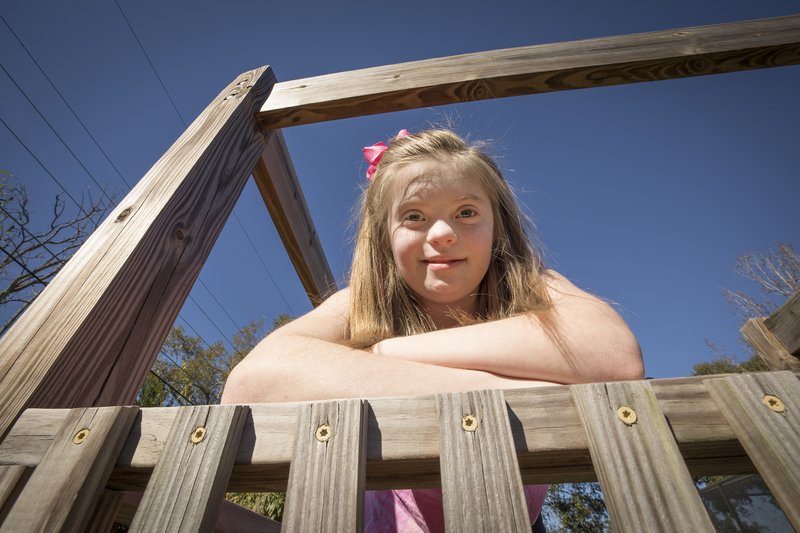
LAKELAND, Fla. (AP) — Brogan Paul, 11, is unstoppable.
The 4-foot-5-inch dynamo models, acts, dances and is a cheerleader when she isn’t in her fourth-grade class at Resurrection Catholic School.
“That’s a daddy/daughter day recital,” Brogan said, pointing in a photo album at a picture showing her and her father, Lakeland dentist Dr. John Paul, dancing.
Brogan has a resume with professional headshots, listing modeling gigs like Gap Kids and New York Fashion Week. What’s also listed is the fact that she has Down syndrome and is a “proud self-advocate … Her experience and presence in advertising campaigns has sparked important conversations about inclusion, teaching kindness, positivity and acceptance for all,” her mother, Sharon Paul, wrote.
Paul explained that Brogan’s condition wasn’t diagnosed until she was 6 weeks old. That’s when doctors noticed that Brogan had low muscle tone and decided to run a test for Down syndrome — a test for an extra 21st chromosome her mom opted out of when she was pregnant with the little girl.
“My husband was like, ‘What are you going to do about it?’” Paul, 54, remembers him asking. Her answer, after seven miscarriages, was “Nothing.” And so they decided against it.
According to the Centers for Disease Control and Prevention, approximately one in every 700 babies in the United States is born with Down syndrome — about 6,000 babies a year in the United States. The cause is still unknown, but maternal age is one factor.
According to the National Down Syndrome Society, a 35-year-old woman has about a 1 in 350 chance of conceiving a child with Down syndrome. The chance increases gradually to 1 in 100 by age 40. At age 45 the incidence becomes approximately 1 in 30.
“I was in a puddle” after the diagnosis, said Paul, who was 43 years old when Brogan was born. She added that she had worked in early intervention therapy as a graduate student in mental health counseling, so she knew the difficult road she and her husband were headed down.
When the test came back positive, doctors also ran a cardiology screening and found Brogan had a hole in her heart — common among people with an extra 21st chromosome.
At eight months old, Brogan underwent open-heart surgery at the University of Florida Health Shands Hospital in Gainesville.
“It’s very traumatic for parents,” Paul explained, adding that Brogan has no lingering heart problems and is even quite proud of her “pirate scar.”
Because she had worked in early intervention, Paul knew she wanted to start physical and occupational therapy, along with speech and developmental therapy, as early as possible to help Brogan thrive. Therapists would come to their home to work with Brogan, but also to teach the Pauls how to help their child.
“We’re very proactive and give her as much support as we can,” Paul said, adding that if there is anything she could tell parents facing the same diagnosis, it is to obtain those early intervention therapies for their children, too.
The support they provided to Brogan included enrolling her in dance classes from the time she began walking at 27 months. And they encouraged her modeling career, which began when an agent saw Brogan’s picture when she was 18 months old. At first her mother was against it.
“I thought, ‘No, that’s weird. Why would I do that?’” Paul said, adding that the agent changed her mind. “They said that seeing Brogan is, maybe, going to give another parent hope.”
And so Brogan, with long dirty blonde hair, big blue eyes and a bright smile, has hit the runways in Miami, Orlando and New York, done gigs for Matilda Jane Clothing, Tampa Bay Parenting magazine and KK Swimwear.
She also has been a Tampa Bay Buccaneers Junior Cheerleader and performed in local theater productions of “The Nightmare Before Christmas,” ″Willy Wonka” and “The Little Mermaid Jr.”
Both the Pauls say they want to see Brogan try whatever interests her.
“Given the opportunity — that’s the important thing,” her mother said. “Brogan has been fortunate to be given the opportunity. We’ve looked at it as you’ve just got to do it and take the chance.”
Dr. Paul said the life expectancy for people with Down syndrome used to be 40-45 years old. Now, with medical advancements, he’s not sure.
“You have no idea what the future holds — no more if your child is typical or not,” he said. “Nobody knows where the top end is … We’re doing heart surgery on infants in the womb.”
John added that because he’s a dentist, he knew they could use expanders on Brogan’s teeth and mouth so her pallet would not be narrow — another common trait for people with Down syndrome.
“The more you do early intervention for what nature didn’t give you, who knows what the top end is going to be?” he said.
Like any child, Brogan has dreams of what she wants to do and be as an adult, including continuing to model and act.
“Learn to drive, work at Publix — bag and cash out,” Brogan said, nestled on the sofa between her mom and little sister, 5-year-old Harper. “Artist and chef.”








